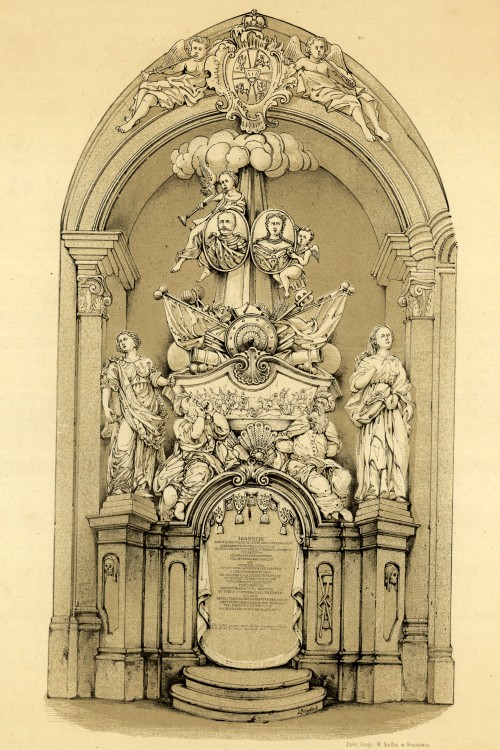
Some monarchs were so unfortunate that their political "job" did not end together with their passing away from this world. This was the case with King Jan III. His first funeral took place in December 1697. Because of the uncertain political situation at that time, there was no official ceremony at the royal necropolis at the Wawel castle in Krakow, but instead, the king was buried in the upper oratory of the Capuchin church at Miodowa Street in Warsaw. A few years later, his grandson, also Jan Sobieski (died in infancy), son of Jakub Sobieski, was buried next to him. His wife, queen Maria Kazimiera, joined him in 1717 (she died one year before in Blois, France), in mysterious circumstances.
According to a legend, one evening, a bell rang at the gate of the Capuchin monastery. When the gate was opened, nobody was there, only a coffin was standing. It happened that Bishop Jan Tarło was at that time staying at the monastery, where he was giving a retreat. He ordered to open the coffin. Inside was a woman with a sceptre and crown, and a medallion in her mouth explaining who she was. Most probably, the Queens' coffin was transported to Poland by Jan III's old servant and war companion, Filip Dupont. King August II ordered to bury Marysieńka next to her husband and organised superb exequiae on 17 March 1717. The Sobieskis rested in peace at the Capuchin monastery until the spring of 1733.
On 1 February that year, August II died and another interregnum started. From the beginning, the favourite of magnates and noblemen was Stanisław Leszczyński, however, when the threat of Russian invasion into the Commonwealth arose, the chances of his main competitor to the throne, Frederick August, Elector of Saxony, son of late king started growing. In April began the pre-election Sejm, where Leszczyński's supporters were in absolute majority. In terms of propaganda, a serious problem for the leaders of this party was... the body of August II displayed at the Warsaw castle royal apartment, which attracted crowds of curious noblemen, who arrived to take part in the Sejm. Every day, 30 holy masses for August II's soul were celebrated in Warsaw churches and bells in all the churches rang for one hour every day to remind people of the Saxon house of Wettin and the Saxon pretender to the Polish crown. This resulted in the idea of organising "competitive" celebrations using the body of Jan III. The corpse of the honoured king of Polish blood was supposed to remind of another "Piast" - as he was then called, namely Stanisław Leszczyński.
On 15 May, the bodies of Jan III, Maria Kazimiera and their grandson were displayed on the superb castrum doloris put up at the Capuchin church. The coffins stood on a five-step catafalque. The king's body was very well preserved, "robust and tough." Those who knew him in person claimed that his face was quite perfect in its similarity to the King when he was still alive, "even the moustache and hair were very little deteriorated." Marysieńska's body was already significantly decayed, but still it was exposed in an open coffin, but the grandson's coffin was closed, due to advanced decay of his body. The royal couple had crowns on their heads, and next to the King's feet, a silver case with his heart was placed. By the bottom step of the catafalque stood stools with regalia on them. Silver candle holders with candles burning all day and night stood around the coffins. The doors and windows were covered in velvet and the floor was covered in red cloth, and there was a bench for dignified visitors upholstered with crimson velvet.
The interior of the church was much richer and more splendid than the church room, where August II rested. In order to achieve the best propaganda effect, a description of the exhibition of the Sobieski bodies in the Capuchin church was promptly published in print.
Although it was not customary, the Senate council decided to transport the bodies of August II, Jan III, Marysieńka and baby Jan from Warsaw to Krakow before the election Sejm, so as to remove any traces of the former king of the Saxon dynasty. On the evening of 10 August 1733, the bodies of the Sobieski family were taken to the castle, and from there they set off on a journey to Krakow on the next day, together with the body of August II. They arrived in Krakow on 20 August. They were carried to Saint Florian's church in Kleparz, where they rested until the funeral. The exequiae took place only on 15 January 1734, before the coronation of August III. Four royal coffins were buried at the Waza family crypt at the Wawel cathedral.
Translation: Lingua Lab
We would like to inform that for the purpose of optimisation of content available on our website and its customisation according to your needs, we use information stored by means of cookies on the Users' end devices. You can control cookies by means of your Internet browser settings. Further use of our website without change of the browser settings means that you accept the use of cookies. For more information on cookies used by us and to feel comfortable about this subject, please familiarise yourselves with our Privacy Policy.
✓ I understand